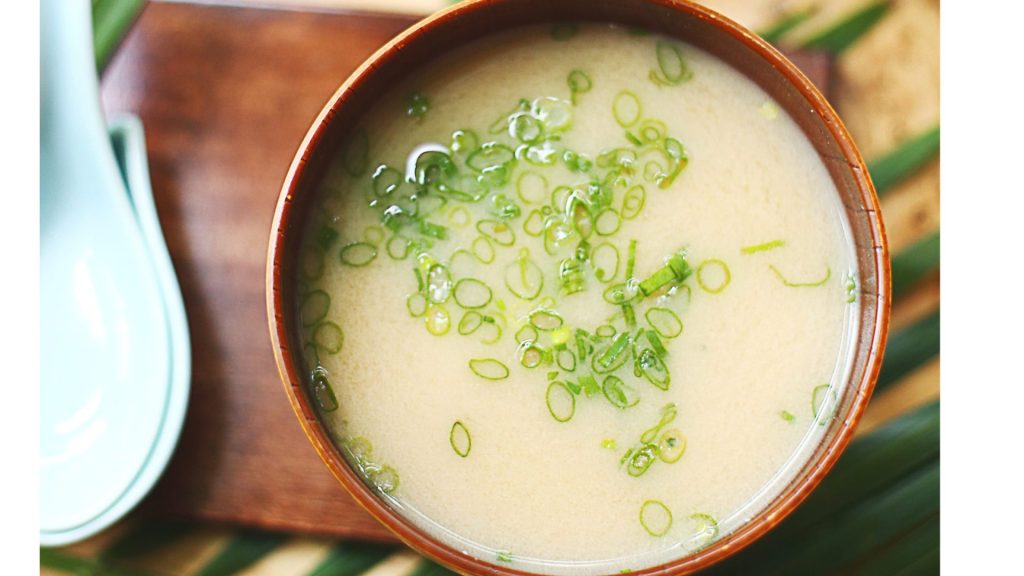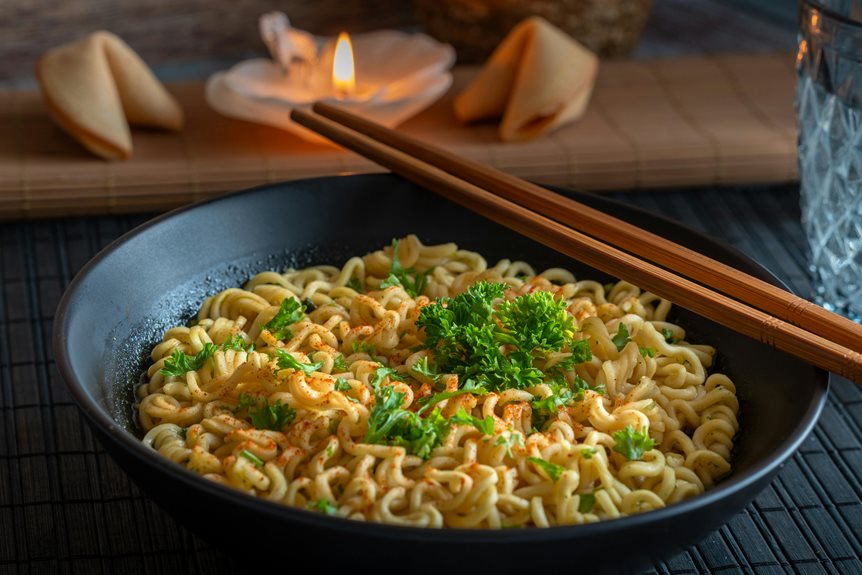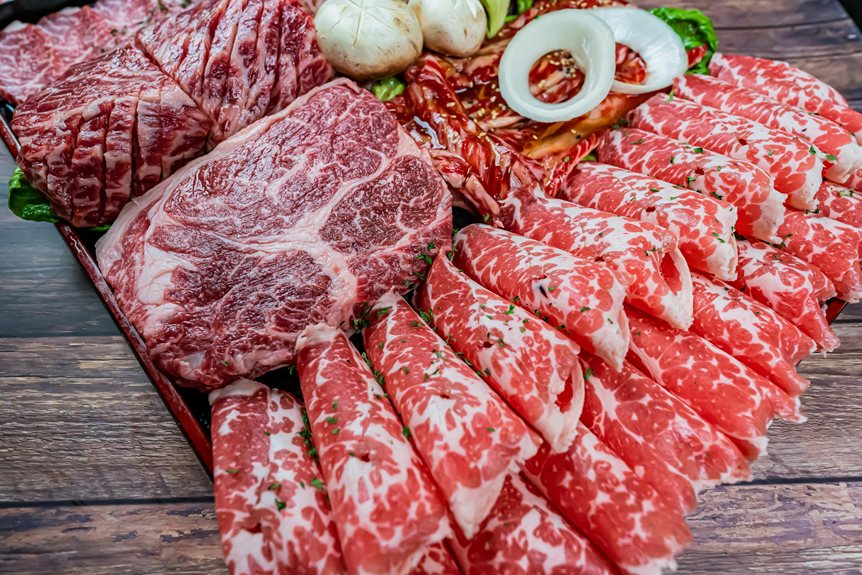Are you craving a comforting bowl of miso soup but don’t have any Dashi on hand? No worries! In this article, we’ll guide you through the process of making delicious miso soup without Dashi.
You’ll discover the rich history behind this traditional Japanese dish and learn about its health benefits.
We’ll also share variations of miso soup recipes to suit your taste preferences.
So, get ready to impress your taste buds with a flavourful homemade miso soup that will warm your soul.
Key Takeaways
- Miso soup originated in Japan and is an integral part of Japanese dining culture.
- Traditional ingredients for miso soup include bonito flakes, kombu, shiitake mushrooms, dried anchovies, soy sauce, and miso paste.
- Miso soup is flavourful and comforting, and the fermentation process enhances its nutritional value.
- There are various variations of miso soup recipes, including spicy, mushroom, vegetable, seafood and citrusy miso soup.
The History of Miso Soup

Miso soup is a traditional Japanese soup made of miso paste and Dashi. This savoury dish has a light broth and is mostly served as an appetiser.
If you want to learn about the history of miso soup, you’re in for an interesting journey!
Miso was introduced in Japan 1300 years ago as fermented food. Made of soybeans, salt and grains, this seasoning formed the basis of Miso soup.
In the Kamakura period, Buddhist monks came to Japan with Suribachi mortars that allowed grain to be ground easily and dissolve in water.
This gave birth to the idea of Miso soup which became the staple meal for Samurai warriors at that time.
Miso paste is mixed with Dashi (a Japanese stock) and various ingredients like tofu, seaweed, or vegetables to create the delicious miso soup we know today.
However, miso soup can also be prepared without Dashi and can be modified in a lot of ways.
Traditional Ingredients in Miso Soup

The traditional ingredients in Miso Soup are:
- Miso Paste
- Dashi
- Tofu
- Seaweed
- Daikon
- Freshwater Clam
- Mushrooms
Traditionally miso soup is made of miso paste and Dashi.
Dashi is the soup stock and traditionally it is made in water containing kelp (Kombu) and bonito flakes (Kezurikatsuo).
These thin, paper-like flakes are made from dried, fermented skipjack tuna and add a rich umami flavor to the soup.
However, miso soup can also be made without Dashi.
Vegetarian Ingredients for Miso Soup
If you’re looking for alternative ingredients or vegan options for your miso soup, there are several options available.
Here are five alternatives to bonito flakes and a way of making your miso soup without dashi in ways that can still provide a delicious taste experience:
- Kombu: This kelp seaweed adds a deep savory flavor to miso soup and is often used as a base for vegetarian dashi broth.
- Shiitake mushrooms: These meaty mushrooms offer an earthy flavor and can be sliced or rehydrated before adding to the soup.
- Dried anchovies: For those who still want a fish-like taste, dried anchovies provide a similar umami kick without being overwhelming.
- Soy sauce: A few dashes of soy sauce can enhance the overall flavor of the miso soup and add depth to each spoonful.
- Miso paste: The star ingredient itself, using different types of miso paste can create unique flavors in your soup. You can make miso soup without dashi and just miso paste.
Variations of Miso Soup Recipes
Try experimenting with different ingredients like tofu, seaweed, and scallions to create unique variations of your miso soup recipe.
It is a versatile dish that can be customised to suit your taste preferences and dietary needs. You can make your miso soup without dashi as well.
Here are five creative variations for your miso soup recipes to inspire you:
- Spicy Miso Soup: Add a kick of heat by incorporating chilli paste or red pepper flakes into your miso broth.
- Mushroom Miso Soup: Enhance the umami flavor by adding assorted mushrooms such as shiitake, oyster, or enoki.
- Vegetable Miso Soup: Load up on fresh vegetables like carrots, broccoli, and bok choy for a nutritious twist.
- Seafood Miso Soup: Include seafood options like shrimp, clams, or salmon to elevate the flavors of your soup.
- Citrusy Miso Soup: Squeeze in some lime or lemon juice for a refreshing and tangy twist.
Tips for Making Miso Soup Without Dashi
You can easily make your miso soup without dashi.
You can make a flavorful broth for your miso soup by using kombu and dried shiitake mushrooms as a base.
These alternative ingredients are perfect for those who prefer vegan options or simply want to switch things up in their miso soup recipe.
Kombu, a type of edible kelp, adds a rich umami flavor to the broth, while dried shiitake mushrooms lend their earthy aroma.
Follow this recipe to make your miso soup without dashi using Kombu and dried shiitake mushrooms:
- To create the broth, soak the kombu and mushrooms in water for about 30 minutes to release their flavors.
- Then, simmer them together over low heat for around 20 minutes.
- Strain the liquid to remove any solids before adding miso paste and other desired ingredients like tofu, green onions, or seaweed.
This simple method ensures a delicious vegan miso soup that will satisfy your taste buds.
Health Benefits of Miso Soup
Miso soup is not only a flavorful and comforting dish, but it also offers numerous health benefits.
One of the main ingredients in miso soup is fermented soybeans, which are rich in essential nutrients such as protein, fiber, vitamins, and minerals.
The fermentation process enhances the nutritional value of soybeans by breaking down complex proteins into easily digestible amino acids.
Additionally, different types of miso paste can be used to create varying flavors and provide unique health benefits.
White miso paste is milder in taste and contains a higher amount of probiotics, beneficial bacteria that promote gut health.
On the other hand, red miso paste has a stronger flavor and is packed with antioxidants that help boost your immune system.
Conclusion
In conclusion, if you’re looking to enjoy a delicious bowl of miso soup but don’t have dashi on hand, fret not!
There are several alternatives and variations that can still deliver a satisfying and flavorful experience.
Whether you choose to use vegetable stock, kombu stock, or even just water as your base, the key is to allow the miso paste to shine with its umami richness.
Don’t forget to experiment with different ingredients such as tofu, seaweed, and scallions to customize your own unique version of this beloved Japanese classic.
Happy cooking!








Konnichiwa! (Hello!) I'm Pat Tokuyama, a Japanese tofu cookbook author, who travels for music, food, and adventure. If you like Japanese tea, checkout some of the newestorganic japanese tea, matcha bowls and noren and more!
** Curious about the Plant Based Japanese Cooking Club? ** Learn more here!